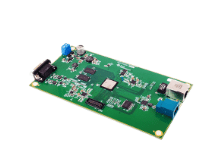This design serves as a resource for engineers looking to develop sophisticated automotive gateway solutions that demand high bandwidth, robust processing power, and compliance with stringent automotive standards.

Serving as a critical node in vehicle communication networks stand alone,automotive gateway facilitates seamless integration and communication among various in-car systems, ensuring that data flows efficiently and securely. This technology is pivotal in supporting advanced driver assistance systems (ADAS), infotainment, telematics, and vehicle-to-everything (V2X) communication, thereby enhancing both the safety and convenience of modern vehicles. As cars become increasingly connected and autonomous, the robustness and reliability of these gateways are essential in managing the growing complexity and volume of data, ultimately contributing to a smarter and safer driving experience. The applications include automotive gateways and multi-function body control modules (BCM) with gateway functionality.
The TIDA-01425 is a comprehensive subsystem reference design by TI tailored for automotive gateways, primarily focusing on enhancing bandwidth and processing power in gateway applications. This design integrates Ethernet physical layer transceivers (PHYs) to boost bandwidth and incorporates an automotive processor to enhance processing capabilities. As a result, automotive gateways can handle more data at significantly higher speeds. Additionally, this design provides an essential foundation for a complete automotive gateway system, including a comprehensive power tree, CAN PHYs, and components meticulously selected to meet automotive requirements and emission standards, thereby streamlining the design process.
The inclusion of a 100BASE-T1 PHY, facilitates Ethernet communication over a single twisted-pair cable. This not only reduces the vehicle’s wiring weight but also significantly enhances overall bandwidth, achieving speeds of up to 100 Mb/s. Alongside the 100BASE-T1 PHY, a 100BASE-TX PHY is implemented to enable diagnostic readings from the vehicle’s various electronic systems. Complementing these Ethernet PHYs, the design also integrates two CAN PHYs to ensure reliable communication with the vehicle’s CAN buses. The automotive processor included in the design is capable of higher processing speeds to accommodate the increased bandwidth and offers software scalability, further enhancing the vehicle’s overall security through software improvements.
It utilizes a processor-based system and supports 100BASE-T1 automotive Ethernet for high-speed communication. Additionally, it includes 100BASE-TX and CAN PHYs to enhance connectivity. The system is powered directly by the automotive battery and remains functional under challenging conditions such as cold crank, jump start, and load dump. It also features power stages designed to minimize electromagnetic interference (EMI) and provides reverse battery protection for added safety and reliability. The DRA71xJ6 Entry processor family, which is scalable and specifically designed for automotive applications, forms the core of this design. The DRA710 processor, in particular, includes an internal gigabit Ethernet (GMAC) switch with two external ports and dual controller area network (DCAN) modules supporting the CAN 2.0B protocol. It features up to 512KB of on-chip L3 RAM, DDR3/DDR4 memory interface supporting up to 2GB across a single chip select, speeds up to DDR-1333 (667MHz), a general-purpose memory controller (GPMC), an enhanced direct-memory-access (EDMA) controller, and sixteen 32-bit general-purpose timers.
Texas Instruments (TI) has thoroughly tested this reference design, which includes a bill of materials (BOM), schematics, assembly drawing, and printed circuit board (PCB) layout. The company’s website provides additional information about this reference design. To learn more, click here.








